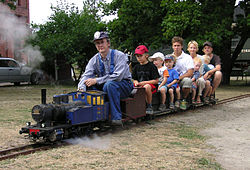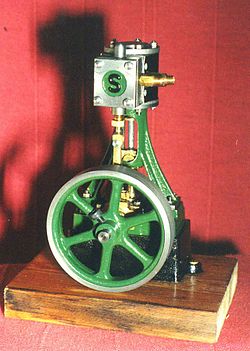- Model engineering
-
Model engineering is the hobby of constructing machines in miniature. The term was in use by 1888.[1] There is some debate about the appropriateness of the term. Some say that all 'engineers' should be professionally qualified as such; however, the historic meaning of 'engineer' is one who constructs or tends engines, and as such is a fitting epithet for those who make working models as a hobby. In the United States, the term home shop machinist is often used.
The 'classic' areas of interest are live steam models (typically steam locomotives, stationary engines and traction engines), internal combustion engines, and clock making. Other popular subjects are Stirling engines, workshop equipment, miniature machine tools and ornamental turning. These constitute stable genres which are often reflected in competition categories at model engineering exhibitions. In the past, amateur electrical experimentation (the precursor to hobby electronics) and ship modelling were considered as part of model engineering, but these are no longer regarded as core genres.
Model engineers typically produce models made in metal. These are machined from stock metal and castings. Some of these are intended as utilitarian working models, others as highly meticulous display models, or sometimes a combination of both. The model engineer usually purchases commercially available drawings which are used as reference to make the models. However some people produce their own drawings, or even work without drawings. The most elaborate models involve hand manufacture of thousands of parts, taking thousands of hours to complete, usually over a number of years or even decades. There are some complete pre-manufactured kits available, but these are limited in the choice of subject matter and are usually expensive.
Contents
Model engineering kits
 A more demanding model engineering project, a propane fired 1:8 scale live steam train, here seen running on the Finnish Railway Museum's miniature 7.25" (184 mm) track.
A more demanding model engineering project, a propane fired 1:8 scale live steam train, here seen running on the Finnish Railway Museum's miniature 7.25" (184 mm) track.
These fall into two categories. Machined kits or unmachined kits. The unmachined kits often consist of drawings, castings, stock metal and all the necessary nuts, bolts and other fixings necessary to complete the model. They require machining facilities to complete. Typically this will include a lathe, drilling machine and possibly a milling machine. A good level of knowledge about machining is necessary to successfully complete these kits. Machined kits are a set of parts that are fully machined and only require finishing with hand tools, painting, etc. Workshop machinery is not required. The kit will typically contain all the parts necessary to complete the kit, including all fixings, pressure gauges and other steam fittings, etc. These kits require a lot less work than an unmachined kit, but are very expensive. Availability tends to be limited as productions runs are small due to the high price.
Building from scratch
Many builders do not use any pre-fabricated parts, ready-made castings, or even drawings. This is called "building from scratch", and it adds another facet to the hobby.
Model engineers
Historically, some of the leading names in the hobby have been those who encourage others through their writings, notably Edgar T. Westbury, "LBSC" (Lillian "Curly" Lawrence), Martin Evans and Tubal Cain (T. D. Walshaw), all writing for the British Model Engineer magazine. Kozo Hiraoka has authored several series of logging locomotive articles in the U.S. magazine Live Steam.
Many of the projects published by these authors contain detailed instructions and drawings for building steam and petrol engines, as well as locomotives in scales ranging from 1:24 to 1:8, capable of carrying passengers on a backyard railroad track.
The quality of work of some modern proponents of the hobby is astonishing, foremost among living model engineers are Cherry Hill, Gerald Wingrove and Barry Jordan.
Tools
Tools used for model engineering include the lathe, the mill, the shaper, and the drill press. Until the introduction of cheap mini-lathes by suppliers such as Warco, Harbor Freight, Grizzly and others, lathes produced by Myford or Bridgeport were fairly ubiquitous in model engineering.[2]
See also
- Bassett-Lowke
- Machining
- Metalworking
- Steam Engine
- Model engine
- Model steam engine
- Carbureted compression ignition model engines
- Glow Engines
External links
References
- ^ Hasluck, P.N., 1888, "The Model Engineer's Handybook", 1st edition. London: Crosby, Lockwood & Son.
- ^ Clark, Andrew J.. "The Model Engineering Clearing House". http://www.modeleng.org/. Retrieved 2009-03-10. "For many years Myford lathes were considered as 'standard issue' for model engineers"
Categories:- Metalworking
- Scale modeling
Wikimedia Foundation. 2010.

